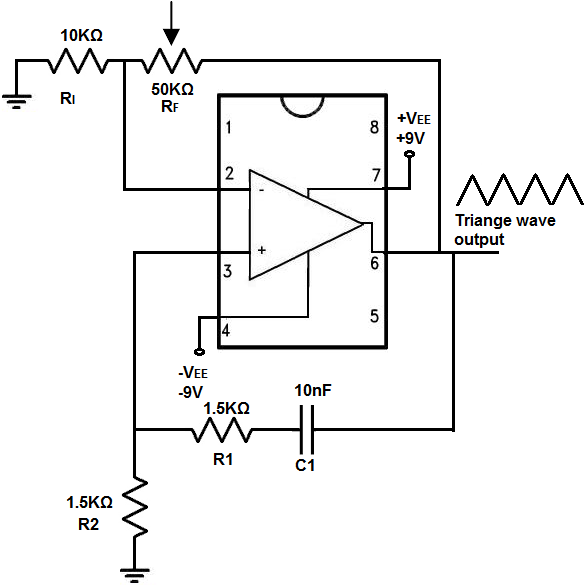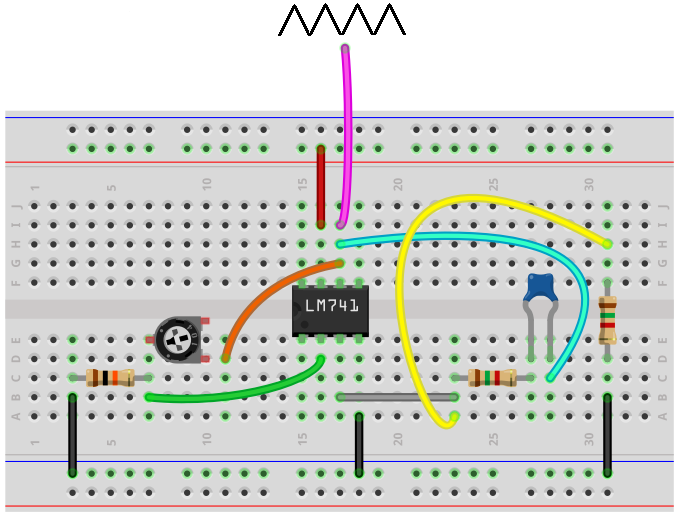How to Build a Triangle Wave Generator Circuit with an LM741 Op Amp

In this project, we will build a triangle wave generator circuit with an LM741 op amp.
A triangle wave generator circuit is a circuit that generates a triangle wave at the output.
Triangle waves are often present in function generators, which is a device that can produce waveforms of all different sorts. Function generators produce waveforms such as sine waves, square waves, and triangular waves. Other waveforms include ramp, pulse, ExRise, ExpFall, Sinc, Noise and DC. Advanced function generators can produce arbitrary waveforms in which you can create basically any type of waveform possible using a variety of math functions. These waveforms aren't always available, though, but almost function generators can produce triangle waveforms. Thus, it's an integral part of many systems.
In this circuit, we're able to build a triangle waveform at the output using an LM741, a few resistors, one capacitor, and one potentiometer.
This circuit closely follows the wien bridge oscillator circuit that we've previously built, which outputs a sine wave signal. The only difference is that instead of 2 RC networks which are present in the wien bridge oscillator circuit, in this circuit, only 1 RC network is present. So instead of having a sine wave signal at the output, we have a triangle wave signal at the output.
This circuit is very crisp, producing a beautiful triangle wave signal at the output, as can be seen in the
video shown below.
Components Needed
- LM741 Op Amp
- 10KΩ resistor
- 2 1.5KΩ resistors
- 10nF ceramic capacitor
- 50KΩ potentiometer
The LM741 is an general-purpose operational amplifier IC.
Since this triangle wave uses an operational amplifier in order to work, the LM741 is our Ic of choice in this circuit.
The LM741 is an 8-pin chip.
If you want to know all the pinout of the LM741 op amp, what each pin is and what each pin does, see LM741 Op Amp Pinout.
As a quick runthrough, we will not be using pins 1, 5, and 8 on this chip.
Pin 2 is the inverting terminal and pin 3 is the noninverting terminal. These are the input terminals of the chip.
Pins 4 and 7 are the power pins of the LM741 in order to power it on. Pin 4 is V- and pin 7 is V+. We connect pin 7 to positive voltage and pin 4 to either ground or negative voltage. In this circuit, we connect it to negative voltage.
And, lastly, pin 6 is the output. This is the pin which the output triangle wave will come out of.
The connections are shown below.
Triangle Wave Generator Circuit Built with an LM741
The triangle wave generator circuit that we will build with an LM741 op amp is shown below.

The breadboard circuit of the circuit above is shown below.

First and foremost, we use about about 9V to power the circuit.
We connect +9V to +VEE,pin 7, and -9V to -VEE, pin 4. This establishes the power necessary for the LM741 chip.
So this circuit is made up of several different components, all of which are composed of either resistors, capacitors, or potentiometers.
So there are several formulas that we follow in order to get the frequency and gain that we desire for the circuit.
The frequency, f= 1/2πRC, where π= 3.14, r is equal to the resistance value, and C is equal to the capacitance values. These are for the R1, C1, R2, and C2 values.
The RC network at the bottom of the circuit diagram determines the frequency of the output triangle wave signal.
For this circuit, we're going to create a frequency of 10KHz for the output signal.
To do this, we choose the values of 1.5KΩ for the resistor and 10nF for the capacitor. Doing the math, we get a frequency of, f= 1/2πRC= 1/2π(1.5KΩ)(10nF)= 1/2(3.14)(1500)(.00000001)≈ 10,615Hz. So, more or less, it is equal to 10KHz.
We can easily play around with values in order to change the frequency of the output signal.
If we swap out the 10nF capacitor for a 100nF capacitor, we get a frequency of f= 1/2(3.14)(1500)(.0000001)≈ 1061Hz, which is approximately 1KHz.
If we swap out the capacitor for a 1nF capaictor, we get a frequency of f= 1/2(3.14)(1500)(.000000001)≈ 106,157Hz, which is approximately 100KHz.
We can also do the same thing for the resistor. If we increase the value of the resistance, the frequency decreases. So if we increase the resistor from 1.5KΩ to 15KΩ while keeping the capacitor value unchanged, this will decrease the frequency by 10. If we change the resistor value to 150KΩ while keeping the capacitor value unchanged, this will decrease the frequency by 100.
So all these manipulations can be done in order to change the frequency.
Whatever the resistor R1 is, the resistor R2 should be made to be the same.
Now we can focus on the gain, amplitude of the signal, which is how tall or loud the signal is.
We can adjust the gain of the circuit by adjusting the DC voltage powering the circuit.
Keep in mind that this circuit is very precise and sensitive. The potentiometer must be tuned to the exact right value in order for a good triangle wave to be shown at the output. If the resistance of the potentiometer is too low, you will not get a triangle wave at all at the output. If the gain is too high, the peaks of triangle waves will be clipped and, thus, distorted. The potentiometer has to be adjusted so that there is an undistorted, unclipped triangle wave at the output.
So to sum up this circuit, the op amp chip, in this case, an LM741 is used to create oscillations that are digital, or square, in nature.
The RC networks on the bottom shapes these digital waveforms into triangle waves and they determine the frequency of the triangle wave.
The RC networks form time constants in the circuit to determine how long one cycle is. The resistor-capacitor determines the time constant of the signal because they control the charge-discharge cycle time of the capacitor. The smaller the resistor and capacitor are, the shorter the time constant and, thus, the greater the frequency. This is because with less resistance, there is less impedement to the flow of current. Thus, a greater amount of current can flow more easily through the circuit. The smaller the capacitor, the less charge it can store, so it takes a shorter period of time for the capacitor to charge up. All this equates into a shorter time cycle for the capacitor, which means a greater frequency. Similarly, converse, if the resistor and capacitor value are greater, this creates a longer time constant and shorter frequency. With greater resistance, there is more impedement to the flow of current, so there is less current flow for a given period of time. With a greater capacitor value, the capacitor takes a longer time to charge up. And that's why a longer time cycle exists for the signal and, thus, a shorter frequency.
The output triangle wave signals appears at pin 6 of the op amp, which is the output pin.
Remember that in order to get an output at pin 6, the potentiometer must be carefully tuned. This circuit is a very precise circuit. If the potentiometer isn't tuned precisely, there either will be no signal at the output or a clipped signal. You have to turn the capacitor, so that it just at the right resistance value.
So if you place the positive lead of the oscilloscope on this terminal and
the negative terminal on ground, you should see a triangle wave if the potentiometer is adjusted
correctly.
And this is how a triangle wave generator circuit can be built with an LM741 op amp chip.
To see how this circuit operates in real life, see the video below.
Related Resources
How to Build a Square-to-Triangle Wave Converter Circuit
How to Build a Square-to-Sine Wave Converter Circuit
How to Build a Clock Circuit with a 555 timer
How to Build an Astable Multivibrator Circuit with Transistors
How to Build a Multivibrator Circuit with a 4047 chip (for astable mode operation)
How to Build a Voltage-Controlled Oscillator Circuit with a 4046 Chip
How to Build an Oscillator Circuit with a 7414 Schmitt Trigger Inverter Chip
How to Build a Sine Wave Generator Circuit with a 555 Timer
How to Build a Ramp Generator with Transistors
How to Build a Voltage-controlled Oscillator with a 555 Timer Chip